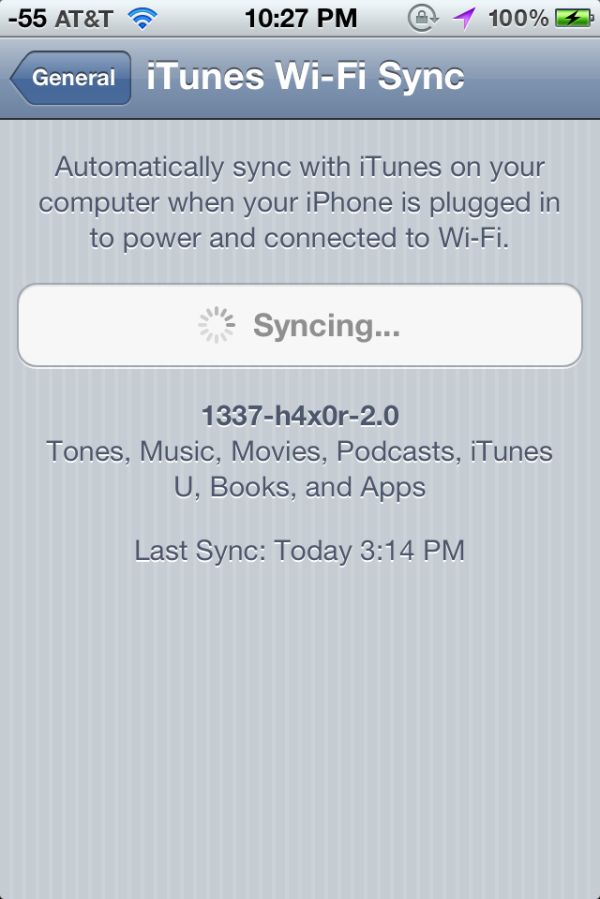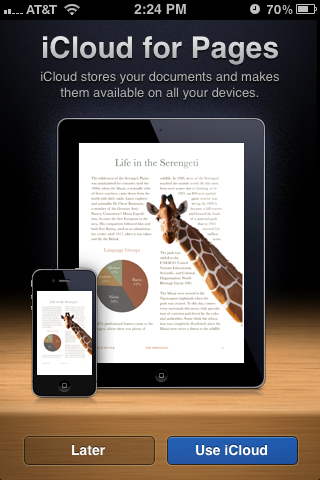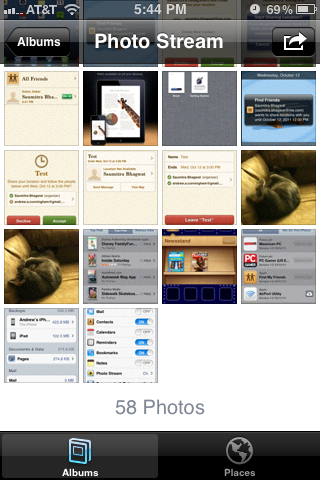Apple iOS 5 Review
by Vivek Gowri, Andrew Cunningham, Saumitra Bhagwat & Brian Klug on October 18, 2011 3:05 AM ESTiTunes Wi-Fi Sync

Another much requested feature that finally makes its debut in iOS 5 is wireless syncing. Apple calls it iTunes Wi-Fi Sync and its introduced under the PC Free initiative that ironically has a USB cable and a pair of scissors as its marketing icon. Unfortunately, iTunes Wi-Fi Sync asks that your phone be connected to a power source for the feature to work. This shouldn’t be too hard to grasp considering the massive power drain issues people would have inevitably faced had it not been otherwise.
As long as your Mac/PC and your iOS device are on the same network, iTunes Wi-Fi Sync automatically kicks in and syncs your device. A new iTunes Wi-Fi Sync option under General Settings lets users follow the syncing process as it goes along and a new sync icon in the status bar notifies users when their device is syncing from anywhere in the OS. iTunes Wi-Fi sync also enables one device to be synced to more than one PC or Mac. Users have granular control over what gets synced with each machine; for example, if you have a machine at work and one at home, you could have your music synced only on the home machine as long as both computers are authorized with your Apple ID.
Documents in the Cloud
As a supplement to some of iCloud features, Apple has released a new set of APIs that let developers build in iCloud functionality into their apps. So for example, if you create documents or spreadsheets using programs other than iWork for iOS, then developers can leverage these new APIs and allow their apps to backup documents to iCloud, which are then pushed to all your other devices automatically. You can read more about this feature and its integration into the iCloud.com site in our companion piece about iCloud on the desktop.
Photo Stream
Photo Stream essentially allows users to backup and store up to 1,000 recent photos imported or taken on their iOS devices and have them pushed down to their Mac and other iOS devices. A new version of iPhoto (9.2) with Photo Stream makes sure the latest photos from your iOS devices can be viewed and saved on your Mac. iCloud saves your photos uploaded via Photo Stream for 30 days before discarding them - otherwise, you can delete all of your Photo Stream photos in the Advanced settings on iCloud.com, or you can wait for them to disappear. There's no way to delete individual photos from the stream in a way that will propagate across all of your devices, which seems like a pretty serious oversight - any photo taken, no matter how embarrassing or compromising, is automatically sent to every other Photo Stream enabled device you've got. In this case, the feature works a little too well. Photo Stream also works with the newest Apple TV update and makes the stream visible there as well.
Photo Stream at this point only syncs photos when you're connected to WiFi, so you have a bit of of time to delete things before they're synced. For users with no WiFi, this restriction does diminish the functionality of Photo Stream, and at present unfortunately there's no way to force photos to sync over cellular data for users with unlimited data plans. At least not without a jailbreak, yet.













86 Comments
View All Comments
myxiplx - Tuesday, October 18, 2011 - link
Just a note, my 3GS is far more responsive since installing IOS 5 than it's been for years. It's not just application launch times, popups, and notifications are a lot snappier, there's a definite reduction in the lag that's been creeping up over the last year.lurker22 - Tuesday, October 18, 2011 - link
Wow, I have found it lags a bit more than ios4kmmatney - Tuesday, October 18, 2011 - link
I'm still running iOS 4.0 (can't upgrade easily due to jailbreak for tethering) and its not all that bad once you disable Spotlight search. I'm hoping they have an untethered Jailbreak for iOS 5 soon, though.lurker22 - Tuesday, October 18, 2011 - link
Anand,Surprised you missed this large flaw. iPads will not receive iMessages sent to your cellular number, just iMessages sent to the email addresses setup in the iMessage account.
This is a huge flaw. What has already happened to me is people using their iPads have missed messages for many hours since they were addressed to the cell number and this then isn't devlivered to the iPads.
Why would apple miss this huge functionality gap? It means now I have to remember to send iMessages to email addresses to be sure the person will see it in a timely fashion.
Aikouka - Tuesday, October 18, 2011 - link
That explains why I never saw any of the "iMessages" that a friend sent me the other day. I was wondering why they didn't show up when I poked around the Messaging app on my iPad. I assumed all you had to do was sign into the same iMessage account to share everything.Brian Klug - Tuesday, October 18, 2011 - link
That's all you have to do for things to work, however there's a catch that I mention - both devices have to be configured to have the same iMessage "Caller ID." This is why the default Caller ID is set to the iMessage "Apple ID" email account, and also the other catch is that your sender has to then be talking with that contact.-Brian
windywoo - Tuesday, October 18, 2011 - link
If Apple is just now implementing features that have been around on other phones why do their products always get such high scores in reviews? Why is it acceptable for Apple to trail in features while Android handsets will be marked down if there happens to be a flicker in the animations? Don't tell me it's because Apple does it so much better because that's subjective at best, and to my mind dishonest.All the features implemented here fix major usability flaws in iOS that really contradict the general view that Apple's products are the easiest to use, but for some reason Apple has got a pass from reviewers like some favoured, hobbit haired child.
I would like to see fewer double standards. We are talking about a capitalist, profit driven corporation, I think they can stand to be handled a little less gently.
lurker22 - Tuesday, October 18, 2011 - link
Here's whyhttp://dinnerwithandroid.tumblr.com/post/115710967...
windywoo - Tuesday, October 18, 2011 - link
That article is a prime example of what I'm talking about. Subjectives passed off as objectives. Until recently the android browser was ahead in any benchmarks yet he claims it's slow. And in any case, Android gives a choice of browser if there are any rendering errors. Safari is not without its own flaws, and when it does go wrong you're stuck, because Apple doesn't allow other browsers.He finds Widgets useless, but doesn't appreciate that other people might not and Android allows them the freedom to spend battery juice on trinkets like live wallpaper if they so choose. Why is it that Apple users always consider it an advantage to have Apple make decisions for them and will pay over the odds to be nannied?
The market argument is almost entirely irrelevant. Let's leave aside the fact that he can't have looked very closely if he thinks there is no software on the Android market, the same argument used to be addressed at Macs. Apple fans would claim then that the quantity didn't matter so long as the major functions were there. Apps are a con anyway. If consumers weren't so gullible, many of them could be written as web apps, making platform irrelevant. But consumers are dumb. They like being fed nuggets of code like junk food.
He lists the good things at the end so why does he consider them less important than what he sees as faults? The answer is of course, fawning subservience to the mighty Apple.
Phynaz - Tuesday, October 18, 2011 - link
Who told you Apple doesn't allow other browsers. I've tried at least three alternatives, and my current browser is Atomic.